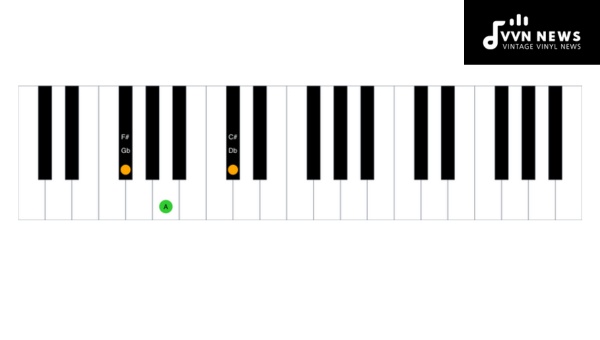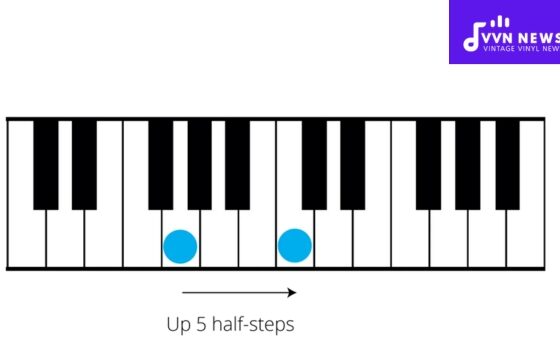If you’ve ever glanced at a piece of music, you might have noticed various symbols, each denoting a specific pitch or note that guides the melody and harmony.
Among these is the G flat music note, a semitone lower than G natural and one that offers a rich depth to compositions.
For those starting their musical journey or simply curious about the nuances of reading music, becoming familiar with the G flat music note is an essential step.
It can be found on various instruments and in numerous pieces, acting as a building block for crafting complex musical structures.
Here, we’ll break down its significance and offer insights into how recognizing and playing the G flat can enhance your musical skillset or appreciation.
How is the G Flat Note Represented on the Staff?
In musical notation, the G flat note is often symbolized as “Gb” and appears on the staff where you’d normally find G natural.
However, it’s marked with a flat sign (♭), which resembles a lowercase “b.” This symbol is placed to the left of the G note.
On a treble clef, G flat is located on the second line from the bottom of the staff, just below the G natural position. In bass clef, you’ll spot it hovering above the second top line.
Recognizing this flat sign is essential—it signals you to play or sing a semitone lower than the natural pitch of G.
G Flat Note on Piano and Keyboard Layouts

On a piano or keyboard, the G flat (Gb) note is the black key immediately to the left of the white G key.
This note is enharmonically equivalent to F sharp (F#), meaning it produces the same pitch but is used differently based on the musical context.
To locate Gb, find any group of three black keys and identify the first one. That’s your G flat.
Easy to spot, this note is essential for playing scales and chords in certain keys.
When you begin playing pieces in E flat minor or D flat major, for instance, getting comfortable with Gb becomes pivotal for fluid performances.
Also Read: The Beatles And Klaatu 2025 [Top Songs of Klaatu]
What accidentals are associated with a G Flat note?
When you encounter a G Flat note in music, it’s invariably linked with the accidental known as the flat (♭).
This symbol instructs you to play the note a half step lower than G natural.
However, in certain contexts, G Flat might also appear as F Sharp (F♯), which sounds the same due to the concept of enharmony where two different names refer to the same pitch in equal temperament tuning systems.
It is also possible to see a G Flat paired with other accidentals in more complex musical pieces. For instance:
- Double flat (♭♭): Although less common, a double flat would lower the G natural note by two semitones, effectively making it an F natural in standard tuning. This would be written as G♭♭.
- Natural sign (♮): In cases where a piece shifts keys or modulates, you might see a natural sign used to cancel out the flat and return to G natural.
Remembering these associations is crucial for interpreting music accurately. Whether you are reading sheet music or improvising, knowing how accidentals affect a note like G Flat will help maintain your pitch accuracy and overall musical integrity.
Representation of G Flat Notes in Different Clefs

The G flat note, while a single pitch, can be represented in various positions on the staff depending on the clef being used.
Each clef assigns a different range to the staff lines, which alters where you will find G flat.
Let’s explore how this note is depicted across several commonly used clefs.
Also Read: Who Was The Fifth Beatle? [George, Ringo, John & Paul]
Treble Clef
In the treble clef, also known as the G clef, G flat is typically found on the second line from the top of the staff when using a ledger line below.
In written music for instruments like the violin or flute and higher vocal ranges, this is where you’ll spot it.
Bass Clef
Conversely, when we look at the bass clef or F clef, G flat appears on the second line from the bottom of the staff without needing any additional ledger lines.
This positioning is key for lower-pitched instruments such as cello or bass and lower male voice types.
Alto Clef
The alto clef centers around middle C. Here you will find G flat placed just above middle C, requiring one ledger line above this central note—important for violists and other mid-range instruments.
Tenor Clef
Similar to alto but slightly higher is tenor clef; it places G flat one ledger line above where it would be in alto clef.
Instruments with ranges that extend higher than those comfortable in bass or alto often use this.
Mezzo-Soprano Clef
Rarely seen today but historically used for mezzo-soprano singers is the mezzo-soprano clef. The notation for G flat would be found directly on the middle C’s line if utilizing this notation style.
Soprano Clef
Equally archaic is soprano clef which transposes everything up an octave from tenor. Consequently, its representation of G flat lies significantly higher compared to other non-vocal specific clefs.
Baritone Clef
We have baritone clef—a mirror to mezzo-soprano but for lower ranges—where you’ll encounter our elusive note sitting snugly below middle C without ledger lines needed.
From treble to baritone, each clef adapts to suit a specific tonal range of voices and instruments ensuring that G flat maintains its sonic character no matter what context it’s placed in.
By understanding these variances across different clefs, musicians gain a more comprehensive grasp of how music notation operates as a universal language.
Also Read: 15 Bass Programming Tips For MIDI & Synths [Step Up Your Beat]
Scales that start with G Flat
When you dive into scales beginning on G flat, one of the key scales to grasp is the G flat major scale.
It consists of the pitches G♭, A♭, B♭, C♭, D♭, E♭, and F. You’ll notice that this scale is enharmonically equivalent to the F# major scale – simply put, they contain the same pitches but are written differently depending on the key and context.
Another significant scale that starts with a G flat is the G flat natural minor scale.
This one features a slightly different set of notes: G♭, A♭, B♭♭ (which is enharmonically equal to A natural), C♭, D♭, E♭ƒ (E double-flat or D natural), and F.
Here again, familiarity with enharmonic equivalents is essential for understanding and playing this scale correctly.
Effectively utilizing these scales in music demands not just memorization but also recognizing their diverse applications across genres and contexts.
Modes Starting from the G Flat Note

When venturing into the world of music theory, you’ll soon encounter modes, which are alternatives to the traditional major and minor scales.
Modes offer unique sounds and emotional qualities, making them an exciting area for experimentation.
Starting from the G flat note, each mode provides a different color or mood in music composition and improvisation.
The Ionian Mode or G Flat Major Scale
The Ionian mode is simply another name for the major scale. A G Flat Major scale would start on the G flat note (G♭) and follow with the sequence of whole and half steps unique to the major scale pattern.
The Dorian Mode on G Flat
The Dorian mode on G Flat would begin with G♭ as its root note but follows a pattern that starts with a whole step, then half, whole, whole, whole, half, and finally another whole step. This results in a scale that has this sequence:
- Starting note: G♭
- Whole step: A♭
- Half step: B♭♭ (enharmonically A)
- Whole step: C♭ (enharmonically B)
- Whole step: D♭
- Whole step: E♭
- Half step: F♭ (enharmonically E)
- Whole step back to G♭
Phrygian Mode Based on G Flat
Delving deeper into modes rooted in G flat, you’d structure the Phrygian starting with a half step instead of a whole. This creates an exotic flavor often found in Spanish music.
Also Read: How To Sell Beats Online [Profit From Your Music Skills]
Lydian Mode with G Flat as Tonic
For something more ethereal or dreamy, try out the Lydian mode beginning with your G flat note. Its distinguishing feature is an augmented fourth interval from its tonic.
Mixolydian Scale Rooted in G Flat
Reminiscent of blues or country melodies, Mixolydian starts on your chosen note but follows by a sequence that includes a minor seventh interval instead of the major seventh found in a major scale.
Aeolian Mode – The Natural Minor Scale on G Flat
Also known as natural minor, Aeolian mode features a series of whole and half steps that give it a melancholic sound when starting from our key note of choice – G flat.
Locrian Mode Featuring G Flat Note
Last among modes but not least intriguing is Locrian. It’s quite rare due to its diminished fifth interval a trait that contributes to its tense and unresolved sound profile.
Understanding how each mode operates starting from the G flat can significantly expand your musical expression. Whether you’re composing new pieces or improvising over chord progressions, exploring these modes opens up worlds of sonic flavors waiting to be discovered.
Frequency of a G Flat Music Note: What is it?
The G flat music note has a specific frequency at which it vibrates, resonating with a pitch that can be distinctly identified.
Concert pitch dictates that the A above middle C vibrates at 440Hz, and using this reference, the G♭ note (also known as F♯) immediately below A typically has a frequency of approximately 369.994Hz.
Understanding this frequency helps musicians tune their instruments accurately and composers craft harmonies that align correctly with standard tuning systems.
Also Read: 33 Best Snoop Dogg Songs [Relive The Iconic Beats Of This Legend]
FAQs about the G Flat Music Note
Where do I find the G flat note on the piano?
The G flat note is typically located to the left of the G natural key on a piano or keyboard.
Can a G flat also be called something else?
Yes, in music, a G flat is enharmonically equivalent to an F sharp, meaning they are the same pitch but notated differently depending on the key or context.
Is G flat major a common key for compositions?
While not as common as some other keys, G flat major does appear in classical and contemporary music, often praised for its warm and lush sound.
How does a G flat affect the mood of a piece?
A G flat can add a sense of somberness or serenity to music, influencing the mood based on its context within a melody or harmony.
What instruments can play a G flat note?
Most melodic instruments such as pianos, guitars, violins, woodwinds, and brass can play a G flat note.
Conclusion
The G flat music note plays a vital role in shaping the emotional texture of a piece.
Whether you’re performing on a piano or composing your own melodies, understanding this note’s nuances contributes to a more profound musical comprehension.
Embrace its versatility and let the resonant tones of G flat enrich your musical endeavors and listening experiences alike.








